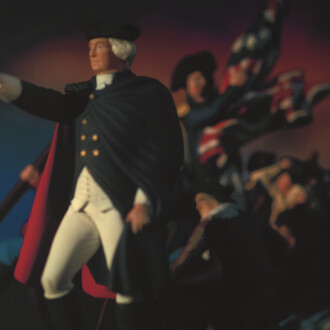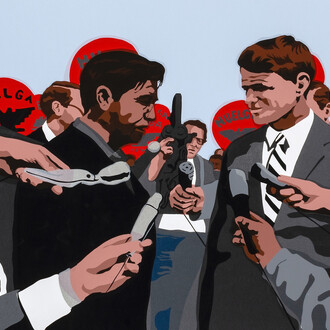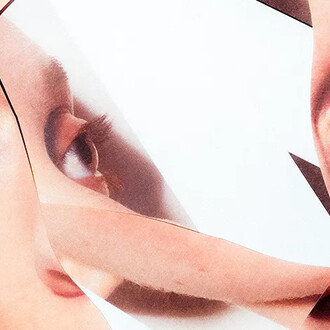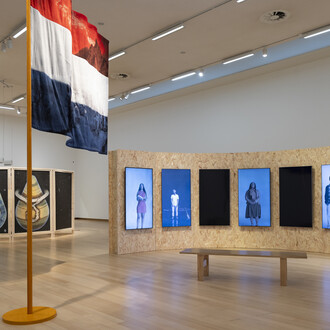Two girls lick their fingers as they eat cake and ice cream. A sheep with a human face walks by, bleating. A woman gives us a penetrating stare before slicing a loaf of bread with an electric knife. The work of Tamara Muller (b. 1975, Wehe den Hoorn, NL) is ambiguous and multifaceted, both in terms of form and content. Is it the menace embodied in the commonplace that makes her paintings so urgent?
‘What I’m currently asking myself is: Do the big themes and extraordinary events in life distract us from the commonplace, or is it the other way around?’ says Tamara. ‘Big things feel very important, but perhaps the small things are actually what counts.’ This question is expressed in her newest series, Distraction, through a multiplicity of things: food, flower motifs, optical illusions. ‘Visual distractions for the viewer. The characters themselves are also distracted, they look up in surprise.’ But don’t let yourself be fooled: their direct gazes distract you from what it’s really all about. As for exactly what that is, Tamara leaves it up in the air.
Her personal life is often the starting point for her work. ‘I am interested in human behaviour – including my own, in relation to the other. Powerlessness and guilt. I see it in newspapers, books, films, and I recognize it in the people around me. I use all of that in my work,’ says Tamara. ‘But it has to feel real, come from me. Only then is it true.’ In her investigation of this theme, distraction has also played a role for herself as an artist. ‘I allow myself little detours, for instance by making a painting within a painting or looking for pictures of fine wallpaper.’ This has resulted in fuller work than previously. But one constant remains: her own face.
How did that ever come about? ‘I was making self-portraits, which really were about me but didn’t necessarily have my face. Now it’s the other way around: I myself provide the occasion for telling a story that is not just about me. Because part of me is already in it, I can take a distance from that story.’ Choosing from a stock of previously made selfies with different facial expressions, she pastes her own head on clippings from magazines. Then, using these collages as a basis, Tamara immediately sets up several paintings at once: ‘By working in a series, it isn’t necessary to put everything in a single painting.’ The paintings each stand on their own, but together they also tell a story in which the borderline between good and bad becomes blurred. ‘It’s a game between the viewer and the artist, in which the character’s role keeps alternating between woman, child, animal, victim and perpetrator. It’s not all that black-and-white.’
















